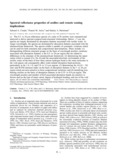| dc.contributor.author | Cloutis, Edward A. | |
| dc.contributor.author | Asher, Pranoti M. | |
| dc.contributor.author | Mertzman, Stanley A. | |
| dc.date.accessioned | 2018-03-07T16:02:31Z | |
| dc.date.available | 2018-03-07T16:02:31Z | |
| dc.date.issued | 2002-09-25 | |
| dc.identifier.citation | Cloutis, E.A., P.M. Asher, and S.A. Mertzman (2002) Spectral reflectance properties of zeolites and remote sensing implications. Journal of Geophysical Research, 107, pp. 5-1 - 5-19. DOI: 10.1029/2000JE001467. | en_US |
| dc.identifier.issn | 0148-0227 | |
| dc.identifier.uri | http://hdl.handle.net/10680/1395 | |
| dc.description.abstract | The 0.3- to 26-μm reflectance spectra of a suite of 28 zeolites were measured and analyzed to derive spectral-compositional-structural relationships. Below ~7 μm, the spectra are largely dominated by absorption features associated with zeolitic water. At longer wavelengths, the spectra are dominated by absorption features associated with the aluminosilicate framework. The spectra exhibit a number of systematic variations which can be used for both structurl and compositional determinations. These include: (1) distinguishing different structural groups on the basis of wavelength position variations
associated with absorption features in the 8.5- to 26-μm region that are related to differences in the structure of the aluminosilicate framework; (2) determining the major cation which is present (Ca, Na, K) and the associated electronic environment of the zeolitic water on the basis of how these cations hydrogen bond to the water molecules in the void spaces and consequently affect water-related absorption band positions, particularly in the 1.4, 1.9, and 2.0- to 2.5-μm regions; (3) determining the Al:(Al + Si) ratio and SCFM chemical index on the basis of absorption features in the 7- to 26-μm region which are most sensitive to these compositional variations; and (4) identifying ironbearing zeolites on the basis of absorption features in the 0.35- to 0.9-μm region. The wavelength position and number of H2O-associated absorption bands are sensitive to factors such as the type of major cation, degree of hydrogen bonding, and size of the void space, all of which are somewhat interrelated. | |
| dc.description.sponsorship | This study was supported by a research grant from the Natural Sciences and Engineering Research Council
of Canada, a contract from the Canadian Space Agency Space Science Program, a discretionary grant from the University of Winnipeg (to E.A.C.), and the Louise McBee Scholarship of the Georgia Association for Women
in Education, University of Georgia (to P.M.A.). | |
| dc.description.sponsorship | This study was supported by a research grant from the Natural Sciences and Engineering Research Council
of Canada, a contract from the Canadian Space Agency Space Science Program, a discretionary grant from the University of Winnipeg (to E.A.C.), and the Louise McBee Scholarship of the Georgia Association for Women
in Education, University of Georgia (to P.M.A.). | |
| dc.description.uri | https://agupubs.onlinelibrary.wiley.com/doi/abs/10.1029/2000JE001467 | |
| dc.language.iso | en | en_US |
| dc.publisher | Journal of Geophysical Research | en_US |
| dc.rights | info:eu-repo/semantics/openAccess | |
| dc.title | Spectral reflectance properties of zeolites and remote sensing implications | en_US |
| dc.type | Article | en_US |
| dc.identifier.doi | 10.1029/2000JE001467 | |
| dc.identifier.doi | 10.1029/2000JE001467 | |

